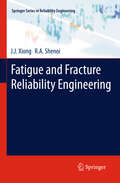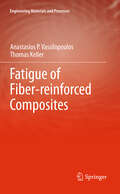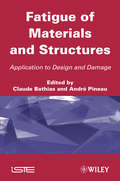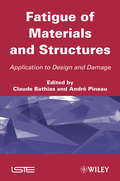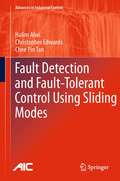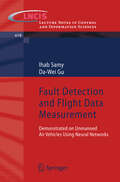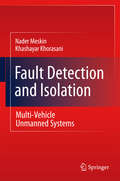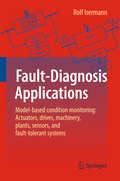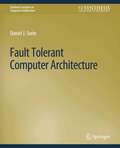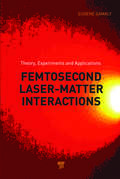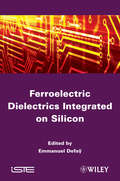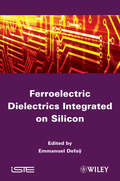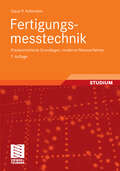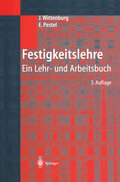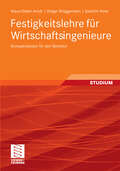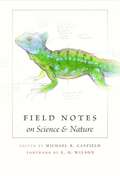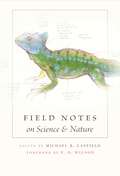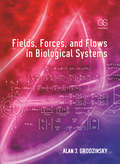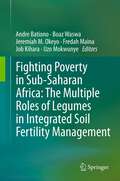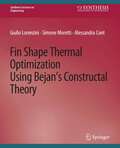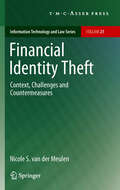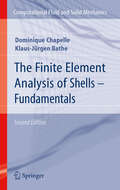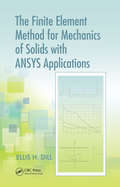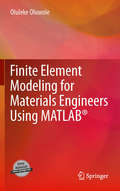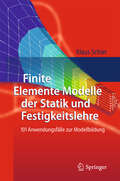- Table View
- List View
Fatigue and Fracture Reliability Engineering (Springer Series in Reliability Engineering)
by J.J. Xiong R.A. ShenoiFatigue and Fracture Reliability Engineering is an attempt to present an integrated and unified approach to reliability determination of fatigue and fracture behaviour, incorporating probability, statistics and other related areas.A series of original and practical approaches, are suggested in Fatigue and Fracture Reliability Engineering, including new techniques in determining fatigue and fracture performances. It also carries out an investigation into static and fatigue properties, and into the failure mechanisms of unnotched and notched CFR composite laminates with different lay-ups to optimize the stacking sequence effect. Further benefits include:a novel convergence-divergence counting procedure to extract all load cycles from a load history of divergence-convergence waves;practical scatter factor formulae to determine the safe fatigue crack initiation and propagation lives from the results of a single full-scale test of a complete structure; anda nonlinear differential kinetic model for describing the dynamical behaviour of an atom at a fatigue crack tip.Fatigue and Fracture Reliability Engineering is intended for practising engineers in marine, civil construction, aerospace, offshore, automotive and chemical industries. It is also useful reading for researchers on doctoral programmes, and is appropriate for advanced undergraduate and postgraduate programmes in any mechanically-oriented engineering discipline.
Fatigue of Fiber-reinforced Composites (Engineering Materials and Processes)
by Anastasios P. Vassilopoulos Thomas KellerFatigue has long been recognized as a mechanism that can provoke catastrophic material failure in structural applications and researchers are now turning to the development of prediction tools in order to reduce the cost of determining design criteria for any new material. Fatigue of Fiber-reinforced Composites explains these highly scientific subjects in a simple yet thorough way.Fatigue behavior of fiber-reinforced composite materials and structural components is described through the presentation of numerous experimental results. Many examples help the reader to visualize the failure modes of laminated composite materials and structural adhesively bonded joints. Theoretical models, based on these experimental data, are demonstrated and their capacity for fatigue life modeling and prediction is thoroughly assessed.Fatigue of Fiber-reinforced Composites gives the reader the opportunity to learn about methods for modeling the fatigue behavior of fiber-reinforced composites, about statistical analysis of experimental data, and about theories for life prediction under loading patterns that produce multiaxial fatigue stress states. The authors combine these theories to establish a complete design process that is able to predict fatigue life of fiber-reinforced composites under multiaxial, variable amplitude stress states. A classic design methodology is presented for demonstration and theoretical predictions are compared to experimental data from typical material systems used in the wind turbine rotor blade industry.Fatigue of Fiber-reinforced Composites also presents novel computational methods for modeling fatigue behavior of composite materials, such as artificial neural networks and genetic programming, as a promising alternative to the conventional methods. It is an ideal source of information for researchers and graduate students in mechanical engineering, civil engineering and materials science.
Fatigue of Materials and Structures: Application to Design and Damage (Iste Ser.)
by Claude Bathias André PineauThe design of mechanical structures with predictable and improved durability cannot be achieved without a thorough understanding of the mechanisms of fatigue damage and more specifically the relationships between the microstructure of materials and their fatigue properties. Written by leading researchers in the field, this book, along with the complementary books Fatigue of Materials and Structures: Fundamentals and Application to Damage and Design (both also edited by Claude Bathias and André Pineau), provides an authoritative, comprehensive and unified treatment of the mechanics and micromechanisms of fatigue in metals, polymers and composites. Each chapter is devoted to one of the major classes of materials or to different types of fatigue damage, thereby providing overall coverage of the field. This book deals with multiaxial fatigue, thermomechanical fatigue, fretting-fatigue, influence of defects on fatigue life, cumulative damage and damage tolerance, and will be an important and much used reference for students, practicing engineers and researchers studying fracture and fatigue in numerous areas of materials science and engineering, mechanical, nuclear and aerospace engineering.
Fatigue of Materials and Structures: Application to Design and Damage
by Claude Bathias André PineauThe design of mechanical structures with predictable and improved durability cannot be achieved without a thorough understanding of the mechanisms of fatigue damage and more specifically the relationships between the microstructure of materials and their fatigue properties. Written by leading researchers in the field, this book, along with the complementary books Fatigue of Materials and Structures: Fundamentals and Application to Damage and Design (both also edited by Claude Bathias and André Pineau), provides an authoritative, comprehensive and unified treatment of the mechanics and micromechanisms of fatigue in metals, polymers and composites. Each chapter is devoted to one of the major classes of materials or to different types of fatigue damage, thereby providing overall coverage of the field. This book deals with multiaxial fatigue, thermomechanical fatigue, fretting-fatigue, influence of defects on fatigue life, cumulative damage and damage tolerance, and will be an important and much used reference for students, practicing engineers and researchers studying fracture and fatigue in numerous areas of materials science and engineering, mechanical, nuclear and aerospace engineering.
Fault Detection and Fault-Tolerant Control Using Sliding Modes (Advances in Industrial Control)
by Halim Alwi Christopher Edwards Chee Pin TanFault Detection and Fault-tolerant Control Using Sliding Modes is the first text dedicated to showing the latest developments in the use of sliding-mode concepts for fault detection and isolation (FDI) and fault-tolerant control in dynamical engineering systems. It begins with an introduction to the basic concepts of sliding modes to provide a background to the field. This is followed by chapters that describe the use and design of sliding-mode observers for FDI using robust fault reconstruction. The development of a class of sliding-mode observers is described from first principles through to the latest schemes that circumvent minimum-phase and relative-degree conditions. Recent developments have shown that the field of fault tolerant control is a natural application of the well-known robustness properties of sliding-mode control. A family of sliding-mode control designs incorporating control allocation, which can deal with actuator failures directly by exploiting redundancy, is presented. Various realistic case studies, specifically highlighting aircraft systems and including results from the implementation of these designs on a motion flight simulator, are described. A reference and guide for researchers in fault detection and fault-tolerant control, this book will also be of interest to graduate students working with nonlinear systems and with sliding modes in particular. Advances in Industrial Control aims to report and encourage the transfer of technology in control engineering. The rapid development of control technology has an impact on all areas of the control discipline. The series offers an opportunity for researchers to present an extended exposition of new work in all aspects of industrial control.
Fault Detection and Flight Data Measurement: Demonstrated on Unmanned Air Vehicles using Neural Networks (Lecture Notes in Control and Information Sciences #419)
by Ihab Samy Da-Wei GuThis book considers two popular topics: fault detection and isolation (FDI) and flight data estimation using flush air data sensing (FADS) systems. Literature surveys, comparison tests, simulations and wind tunnel tests are performed. In both cases, a UAV platform is considered for demonstration purposes. In the first part of the book, FDI is considered for sensor faults where a neural network approach is implemented. FDI is applied both in academia and industry resulting in many publications over the past 50 years or so. However few publications consider neural networks in comparison to traditional techniques such as observer based, parameter estimations and parity space approaches. The second part of this book focuses on how to estimate flight data (angle of attack, airspeed) using a matrix of pressure sensors and a neural network model. In conclusion this book can serve as an introduction to FDI and FADS systems, a literature survey, and a case study for UAV applications.
Fault Detection and Isolation: Multi-Vehicle Unmanned Systems
by Nader Meskin Khashayar Khorasani“Fault Detection and Isolation: Multi-Vehicle Unmanned System” deals with the design and development of fault detection and isolation algorithms for unmanned vehicles such as spacecraft, aerial drones and other related vehicles. Addressing fault detection and isolation is a key step towards designing autonomous, fault-tolerant cooperative control of networks of unmanned systems. This book proposes a solution based on a geometric approach, and presents new theoretical findings for fault detection and isolation in Markovian jump systems. Also discussed are the effects of large environmental disturbances, as well as communication channels, on unmanned systems. The book proposes novel solutions to difficulties like robustness issues, as well as communication channel anomalies. “Fault Detection and Isolation: Multi-Vehicle Unmanned System” is an ideal book for researchers and engineers working in the fields of fault detection, as well as networks of unmanned vehicles.
Fault-Diagnosis Applications: Model-Based Condition Monitoring: Actuators, Drives, Machinery, Plants, Sensors, and Fault-tolerant Systems
by Rolf IsermannSupervision, condition-monitoring, fault detection, fault diagnosis and fault management play an increasing role for technical processes and vehicles in order to improve reliability, availability, maintenance and lifetime. For safety-related processes fault-tolerant systems with redundancy are required in order to reach comprehensive system integrity. This book is a sequel of the book “Fault-Diagnosis Systems” published in 2006, where the basic methods were described. After a short introduction into fault-detection and fault-diagnosis methods the book shows how these methods can be applied for a selection of 20 real technical components and processes as examples, such as: Electrical drives (DC, AC)Electrical actuatorsFluidic actuators (hydraulic, pneumatic)Centrifugal and reciprocating pumpsPipelines (leak detection)Industrial robotsMachine tools (main and feed drive, drilling, milling, grinding)Heat exchangers Also realized fault-tolerant systems for electrical drives, actuators and sensors are presented. The book describes why and how the various signal-model-based and process-model-based methods were applied and which experimental results could be achieved. In several cases a combination of different methods was most successful. The book is dedicated to graduate students of electrical, mechanical, chemical engineering and computer science and for engineers.
Fault Tolerant Computer Architecture (Synthesis Lectures on Computer Architecture)
by Daniel SorinFor many years, most computer architects have pursued one primary goal: performance. Architects have translated the ever-increasing abundance of ever-faster transistors provided by Moore's law into remarkable increases in performance. Recently, however, the bounty provided by Moore's law has been accompanied by several challenges that have arisen as devices have become smaller, including a decrease in dependability due to physical faults. In this book, we focus on the dependability challenge and the fault tolerance solutions that architects are developing to overcome it. The two main purposes of this book are to explore the key ideas in fault-tolerant computer architecture and to present the current state-of-the-art - over approximately the past 10 years - in academia and industry. Table of Contents: Introduction / Error Detection / Error Recovery / Diagnosis / Self-Repair / The Future
Femtosecond Laser-Matter Interaction: Theory, Experiments and Applications
by Eugene G. GamalyThis is the first comprehensive treatment of the interaction of femtosecond laser pulses with solids at nonrelativistic intensity. It connects phenomena from the subtle atomic motion on the nanoscale to the generation of extreme pressure and temperature in the interaction zone confined inside a solid. The femtosecond laser-matter interaction has al
Ferroelectric Dielectrics Integrated on Silicon
by Emmanuel DefaÿThis book describes up-to-date technology applied to high-K materials for More Than Moore applications, i.e. microsystems applied to microelectronics core technologies. After detailing the basic thermodynamic theory applied to high-K dielectrics thin films including extrinsic effects, this book emphasizes the specificity of thin films. Deposition and patterning technologies are then presented. A whole chapter is dedicated to the major role played in the field by X-Ray Diffraction characterization, and other characterization techniques are also described such as Radio frequency characterization. An in-depth study of the influence of leakage currents is performed together with reliability discussion. Three applicative chapters cover integrated capacitors, variables capacitors and ferroelectric memories. The final chapter deals with a reasonably new research field, multiferroic thin films.
Ferroelectric Dielectrics Integrated on Silicon
by Emmanuel DefaÿThis book describes up-to-date technology applied to high-K materials for More Than Moore applications, i.e. microsystems applied to microelectronics core technologies. After detailing the basic thermodynamic theory applied to high-K dielectrics thin films including extrinsic effects, this book emphasizes the specificity of thin films. Deposition and patterning technologies are then presented. A whole chapter is dedicated to the major role played in the field by X-Ray Diffraction characterization, and other characterization techniques are also described such as Radio frequency characterization. An in-depth study of the influence of leakage currents is performed together with reliability discussion. Three applicative chapters cover integrated capacitors, variables capacitors and ferroelectric memories. The final chapter deals with a reasonably new research field, multiferroic thin films.
Fertigungsmesstechnik: Praxisorientierte Grundlagen, moderne Messverfahren
by Claus P. KefersteinDieses Lehrbuch führt in Entwicklung, Bedeutung und Zusammenhänge der Mess- und Prüfverfahren für industriell hergestellte Produkte ein. Die Schwerpunkte liegen auf den Verfahren für Messraum und Betrieb, auf den fertigungs- und prozessorientierten Verfahren sowie auf den berührungslosen, optischen Verfahren. Vermittelt werden die Grundlagen der Messtechnik, wie sie in Industrie und Technik Anwendung finden und bei der ingenieurwissenschaftlichen Ausbildung wie auch in der Praxis immer wieder benötigt werden. In der aktuellen Auflage wurde ein Kapitel zur Mikromesstechnik sowie ein deutsch-englisches und englisch-deutsches Sachwortverzeichnis aufgenommen.
Festigkeitslehre: Ein Lehr- und Arbeitsbuch (Klassiker der Technik)
by Jens WittenburgDas Lehr- und Arbeitsbuch erscheint als Nachfolgeband des Lehrbuchs Technische Mechanik Band 2, Festigkeitslehre, von Pestel und Wittenburg. Dafür wurden zwei Teile zu einem Band zusammengefügt: Der erste Teil ist die gründlich überarbeitete Neuauflage des Lehrbuchs und stellt auf anschauliche und mathematisch einfache Weise die Grundzüge der Festigkeitslehre dar. Der zweite Teil liefert ausführlich erklärte Lösungen zu allen 200 Aufgaben des Lehrbuchs und schult Leser darin, technische Fragestellungen in mathematische Gleichungen umzusetzen.
Festigkeitslehre für Wirtschaftsingenieure: Kompaktwissen für den Bachelor
by Klaus-Dieter Arndt Holger Brüggemann Joachim IhmePädagogisch-didaktisch aufbereitetes Werk, das in Kurzform die Theorie der Festigkeitslehre darstellt. Das Werk enthält Beispiele mit Wirtschaftlichkeitsbetrachtungen und Übungsaufgaben zur Verfestigung des Stoffes. Abgestimmt auf eine 4h-Vorlesung für Bachelor, aber auch für Techniker sowie Praktiker im Beruf geeignet.
Field Notes on Science & Nature
by Michael R. CanfieldWhat did George Schaller note when studying the lions of the Serengeti? How does Piotr Naskrecki use relational databases and electronic field notes? In what way is Bernd Heinrich’s approach “truly Thoreauvian,” in E. O. Wilson’s view? Pioneering a new niche in the study of plants and animals in their native habitat, Field Notes on Science and Nature allows readers to peer over the shoulders and into the notebooks of a dozen eminent field workers, to study firsthand their methods, materials, and fleeting impressions. Recording field observations is an indispensable scientific skill, but researchers are not generally willing to share their personal records. Here, for the first time, are reproductions of actual pages from notebooks. And in essays abounding with fascinating anecdotes, the authors reflect on the contexts in which the notes were taken. Covering disciplines as diverse as ecology, paleontology, anthropology, botany, and animal behavior, Field Notes offers specific examples that professional naturalists can emulate to fine-tune their own field methods, along with practical advice that amateur naturalists and students can use to document their adventures.
Field Notes on Science & Nature
by Michael R. CanfieldWhat did George Schaller note when studying the lions of the Serengeti? How does Piotr Naskrecki use relational databases and electronic field notes? In what way is Bernd Heinrich’s approach “truly Thoreauvian,” in E. O. Wilson’s view? Pioneering a new niche in the study of plants and animals in their native habitat, Field Notes on Science and Nature allows readers to peer over the shoulders and into the notebooks of a dozen eminent field workers, to study firsthand their methods, materials, and fleeting impressions. Recording field observations is an indispensable scientific skill, but researchers are not generally willing to share their personal records. Here, for the first time, are reproductions of actual pages from notebooks. And in essays abounding with fascinating anecdotes, the authors reflect on the contexts in which the notes were taken. Covering disciplines as diverse as ecology, paleontology, anthropology, botany, and animal behavior, Field Notes offers specific examples that professional naturalists can emulate to fine-tune their own field methods, along with practical advice that amateur naturalists and students can use to document their adventures.
Fields, Forces, and Flows in Biological Systems
by Alan J GrodzinskyFields, Forces, and Flows in Biological Systems describes the fundamental driving forces for mass transport, electric current, and fluid flow as they apply to the biology and biophysics of molecules, cells, tissues, and organs. Basic mathematical and engineering tools are presented in the context of biology and physiology.The chapters are structure
Fighting Poverty in Sub-Saharan Africa: The Multiple Roles of Legumes in Integrated Soil Fertility Management
by Andre Bationo, Boaz Waswa, Jeremiah M. M. Okeyo, Fredah Maina, Job Kihara and Uzo MokwunyeLegumes play an important role in the cropping systems of sub Saharan Africa (SSA). Legumes are an important source of nutrition to both humans and livestock by providing the much needed protein, minerals, fibre and vitamins. The sale of legumes seed, leaves and fibre generates income for the marginalized communities especially women. Cultivation of legumes is essential for the regeneration of nutrient-deficient soils. By biologically fixing nitrogen (BNF) in the soil, legumes provide a relatively low-cost method of replacing otherwise expensive inorganic nitrogen in the soil. This enhances soil fertility and boosts subsequent cereal crop yields. Production of legumes in SSA is however; hampered by a number of constraints among them low and declining soil fertility, low soil pH, high salinity, drought and flooding, poor access to improved germplasm, diseases, pests and weeds. Farmers need to learn how to overcome these constraints if the full benefits of legumes are to be gained. This book presents a synthesis of research work on legumes and draws attention to the importance of legumes in integrated soil fertility management (ISFM) and poverty alleviation in SSA.
Fin-Shape Thermal Optimization Using Bejan's Constuctal Theory (Synthesis Lectures on Engineering)
by Giulio Lorenzini Simone Moretti Alessandra ContiThe book contains research results obtained by applying Bejan's Constructal Theory to the study and therefore the optimization of fins, focusing on T-shaped and Y-shaped ones. Heat transfer from finned surfaces is an example of combined heat transfer natural or forced convection on the external parts of the fin, and conducting along the fin. Fin's heat exchange is rather complex, because of variation of both temperature along the fin and convective heat transfer coefficient. Furthermore possible presence of more fins invested by the same fluid flow has to be considered. Classical fin theory tried to reduce the coupled heat transfer problem to a one-dimensional problem by defining an average temperature of the fin and writing equations using this parameter. However, it was shown that this approach cannot be used because of the effects of two-dimensional heat transfer, especially in the presence of short fins. CFD codes offer the possibility to consider bi-dimensional (and more generally, three-dimensional) effects and then a more real approach to the physic phenomena of finned surface's heat exchange. A commercial CFD code was used to analyse the case of heat exchange in presence of T-shaped fins, following an approach suggested by Bejan's Constructal Theory. The comparative results showed a significant agreement with previous research taken as a reference, and this result allows for the application of this approach to a wider range of systems. T-shaped optimized fin geometry is the starting point for further research. Starting from the optimal results (T-shape optimized fins), we show the trend of the assessment parameter (the dimensionless conductance) in function of the angle a between the two horizontal arms of the fin. A value for a, 90° < a < 180° capable of a higher value of the dimensionless conductance, has not been found. The thermal efficiency showed a significant increase of this parameter, especially for values of a smaller than 100°. Thus, a new definition of optimisation is achieved by introducing the fundamental ""space factor."" The present work unifies the ""classic"" definitions of optimisation and efficiency in a new general performance criterion, opening a new perspective on multi-fin systems. The last chapter deals with a brief overview on Bejan's Constructal Theory. It explains either tree-shape natural flows or other geometric form in nature and engineering, applying the principle of performance maximization. The Constructal principle also recognizes that a new good form comes to another previous good form which serve the same objective and have the same constraints. Changes in configuration are dynamic, thus a time arrow is then associated to the evolution in system's configuration. Table of Contents: General Introduction / General Overview on Heat Transfer / Conservation Equations / Dimensionless group / Units and conversion factors / Overview of heat transfer on extended surfaces / State of the art in the T-Shaped Fins / Thermal exchange basis / T-Shaped fins / Y-Shaped fins / Modular systems of Y-Shaped fins / Heat removal vs Pressure drops / Conclusions
Financial Identity Theft: Context, Challenges and Countermeasures (Information Technology and Law Series #21)
by Nicole S. van der MeulenThe existence of financial identity theft in the United States, and its (gradual) spread to other areas of the world, increases the need to understand how identity theft occurs and how perpetrators of the crime manage to take advantage of developments within contemporary society. This book aims to provide such an understanding through an in-depth comparative analysis which illustrates how states, financial service providers, consumers, and others facilitate the occurrence of financial identity theft in the United States and the Netherlands.
The Finite Element Analysis of Shells - Fundamentals (Computational Fluid and Solid Mechanics)
by Dominique Chapelle Klaus-Jurgen BatheThis book presents a modern continuum mechanics and mathematical framework to study shell physical behaviors, and to formulate and evaluate finite element procedures. With a view towards the synergy that results from physical and mathematical understanding, the book focuses on the fundamentals of shell theories, their mathematical bases and finite element discretizations. The complexity of the physical behaviors of shells is analysed, and the difficulties to obtain uniformly optimal finite element procedures are identified and studied. Some modern finite element methods are presented for linear and nonlinear analyses. In this Second Edition the authors give new developments in the field and - to make the book more complete - more explanations throughout the text, an enlarged section on general variational formulations and new sections on 3D-shell models, dynamic analyses, and triangular elements. The analysis of shells represents one of the most challenging fields in all of mechanics, and encompasses various fundamental and generally applicable components. Specifically, the material presented in this book regarding geometric descriptions, tensors and mixed variational formulations is fundamental and widely applicable also in other areas of mechanics.
The Finite Element Method for Mechanics of Solids with ANSYS Applications (Advances In Engineering Ser.)
by Ellis H. DillWhile the finite element method (FEM) has become the standard technique used to solve static and dynamic problems associated with structures and machines, ANSYS software has developed into the engineer's software of choice to model and numerically solve those problems. An invaluable tool to help engineers master and optimize analysis, The Finite El
Finite Element Modeling for Materials Engineers Using MATLAB®
by Oluleke OluwoleThe finite element method is often used for numerical computation in the applied sciences. It makes a major contribution to the range of numerical methods used in the simulation of systems and irregular domains, and its importance today has made it an important subject of study for all engineering students. While treatments of the method itself can be found in many traditional finite element books, Finite Element Modeling for Materials Engineers Using MATLAB® combines the finite element method with MATLAB to offer materials engineers a fast and code-free way of modeling for many materials processes. Finite Element Modeling for Materials Engineers Using MATLAB® covers such topics as:developing a weak formulation as a prelude to obtaining the finite element equation,interpolation functions,derivation of elemental equations, anduse of the Partial Differential Equation Toolbox™.Exercises are given based on each example and m-files based on the examples are freely available to readers online.Researchers, advanced undergraduate and postgraduate students, and practitioners in the fields of materials and metallurgy will find Finite Element Modeling for Materials Engineers Using MATLAB® a useful guide to using MATLAB for engineering analysis and decision-making.
Finite Elemente Modelle der Statik und Festigkeitslehre: 101 Anwendungsfälle zur Modellbildung
by Klaus SchierUm die Finite Elemente Methode (FEM) bei anspruchsvollen Aufgaben anwenden zu können, werden Softwaresysteme benötigt. Die Modellbildung rückt damit in den Mittelpunkt der Problemlösung. Der Band vermittelt nach einer kurzen Einführung in die FE-Methode die Abläufe der Modellbildung in allgemeiner Form, das heißt, unabhängig von bestimmten FEM-Programmen. Im Zentrum stehen die Modellbildung an Tragwerken, an Bauteilen bei unterschiedlichen Beanspruchungsarten, die Anwendung verschiedener Elementtypen sowie die Verifizierung der FE-Ergebnisse.
